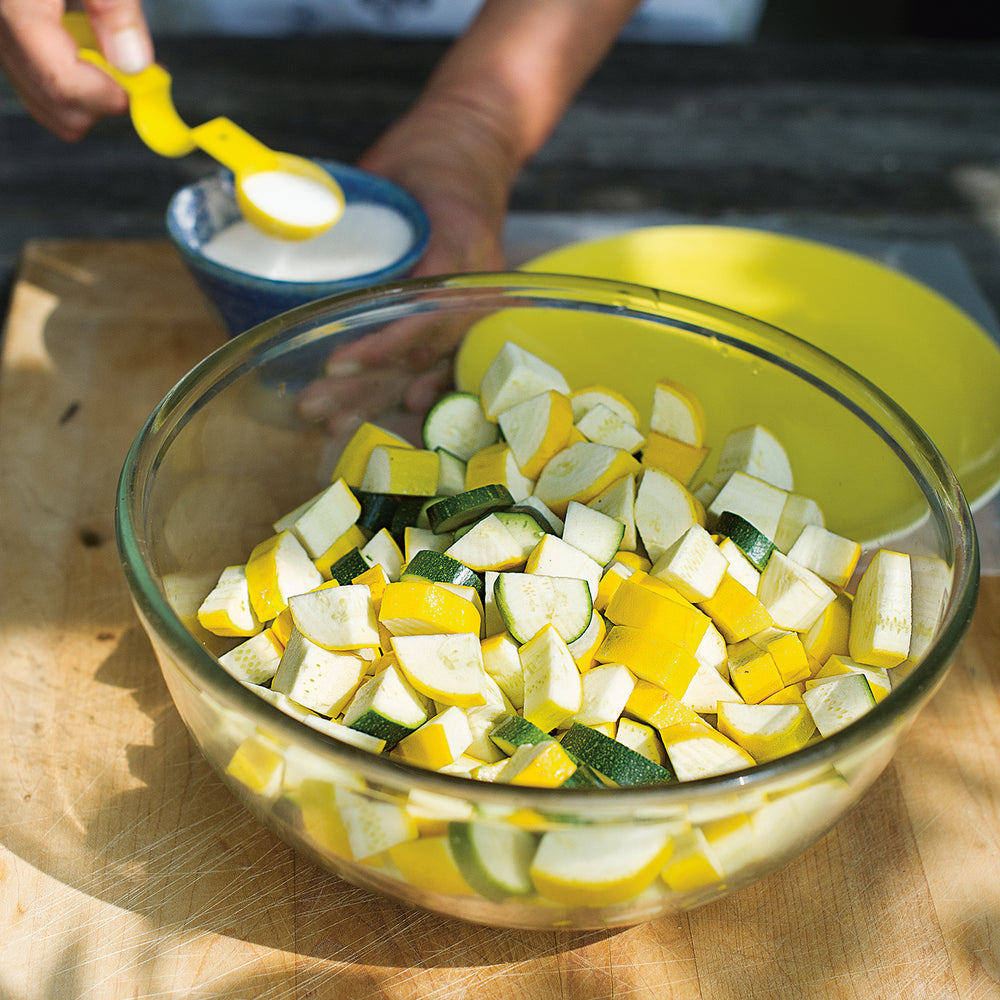1kg courgettes (green or yellow)
2 tbsp fine sea salt
2 medium onions, peeled and sliced
3 fat garlic cloves, peeled and roughly chopped
1–2 chillies, halved and deseeded
40g fresh root ginger, peeled
100ml rapeseed or sunflower oil
1 tbsp coriander seeds
1 tbsp cumin seeds
1 tbsp black mustard seeds
1 tsp ground turmeric
300ml cider vinegar
150g light soft brown sugar
Courgette Chutney
Courgettes are magnificently prolific, which makes them good value when they’re in season in the late summer and early autumn. This chutney is a delicious method of using up gluts if you grow your own. Although my preference is to use tender young courgettes, when they are little more than 15cm long, you can use big courgettes too, either green or yellow.
Coriander and cumin are a classic spice duo and will turn a panful of courgettes into a dazzler of a chutney. Don’t skip toasting the seeds; the few minutes it takes will bring out their best flavour.

1kg courgettes (green or yellow)
2 tbsp fine sea salt
2 medium onions, peeled and sliced
3 fat garlic cloves, peeled and roughly chopped
1–2 chillies, halved and deseeded
40g fresh root ginger, peeled
100ml rapeseed or sunflower oil
1 tbsp coriander seeds
1 tbsp cumin seeds
1 tbsp black mustard seeds
1 tsp ground turmeric
300ml cider vinegar
150g light soft brown sugar
1. Rinse the courgettes, trimming away the stalks. For small courgettes cut crossways into slices about 1.5cm thick; for bigger courgettes, halve and quarter lengthways then cut into chunks. Place in a large bowl and sprinkle with the salt, lightly tossing to coat. Cover with a piece of baking parchment and a plate.
2. Leave the courgettes for at least 2 hours (and up to 4) for the salt to draw out as much moisture as possible. Rinse with cold water, then drain and dry well with kitchen paper.
3. Meanwhile, blitz the onion, garlic, chilli and ginger in a food processor with 50ml of the oil, or pound to a paste with a pestle and mortar. Toast the coriander and cumin seeds for 2–3 minutes in a dry frying pan until fragrant. Remove from the heat and pound to a coarse powder, using a pestle and mortar.
4. Heat the remaining oil in a large heavy-based pan or preserving pan. Sprinkle in the mustard seeds and cook for a couple of minutes until they begin to pop, then stir in the pounded coriander and cumin and the turmeric, and cook for a minute or so. Add the onion paste and cook for a further 5 minutes, stirring frequently to prevent the mixture from catching, before finally adding the courgettes, the vinegar and the sugar. Stir until the sugar has dissolved and everything is well combined.
5. Continue to cook over a gentle heat for about 40 minutes until the liquid has reduced and the chutney is nicely thick, stirring from time to time. Meanwhile, sterilise your jars and twist-on lids.
6. Spoon the cooked chutney into the warm jars, packing down tightly and using the back of a spoon to tease out any air pockets, then seal immediately with twist-on lids. Ideally, leave the chutney for 2–3 weeks or so for the flavours to mingle and mellow.
Store in a cool, dry, dark place for up to a year. Once opened, keep in fridge and use within 3–4 months.
Credit: Pam the Jam: The Book of Preserves (Bloomsbury Publishing, £20) is out now. Photography by Mark Diacono.
1. Rinse the courgettes, trimming away the stalks. For small courgettes cut crossways into slices about 1.5cm thick; for bigger courgettes, halve and quarter lengthways then cut into chunks. Place in a large bowl and sprinkle with the salt, lightly tossing to coat. Cover with a piece of baking parchment and a plate.
2. Leave the courgettes for at least 2 hours (and up to 4) for the salt to draw out as much moisture as possible. Rinse with cold water, then drain and dry well with kitchen paper.
3. Meanwhile, blitz the onion, garlic, chilli and ginger in a food processor with 50ml of the oil, or pound to a paste with a pestle and mortar. Toast the coriander and cumin seeds for 2–3 minutes in a dry frying pan until fragrant. Remove from the heat and pound to a coarse powder, using a pestle and mortar.
4. Heat the remaining oil in a large heavy-based pan or preserving pan. Sprinkle in the mustard seeds and cook for a couple of minutes until they begin to pop, then stir in the pounded coriander and cumin and the turmeric, and cook for a minute or so. Add the onion paste and cook for a further 5 minutes, stirring frequently to prevent the mixture from catching, before finally adding the courgettes, the vinegar and the sugar. Stir until the sugar has dissolved and everything is well combined.
5. Continue to cook over a gentle heat for about 40 minutes until the liquid has reduced and the chutney is nicely thick, stirring from time to time. Meanwhile, sterilise your jars and twist-on lids.
6. Spoon the cooked chutney into the warm jars, packing down tightly and using the back of a spoon to tease out any air pockets, then seal immediately with twist-on lids. Ideally, leave the chutney for 2–3 weeks or so for the flavours to mingle and mellow.
Store in a cool, dry, dark place for up to a year. Once opened, keep in fridge and use within 3–4 months.
Credit: Pam the Jam: The Book of Preserves (Bloomsbury Publishing, £20) is out now. Photography by Mark Diacono.

